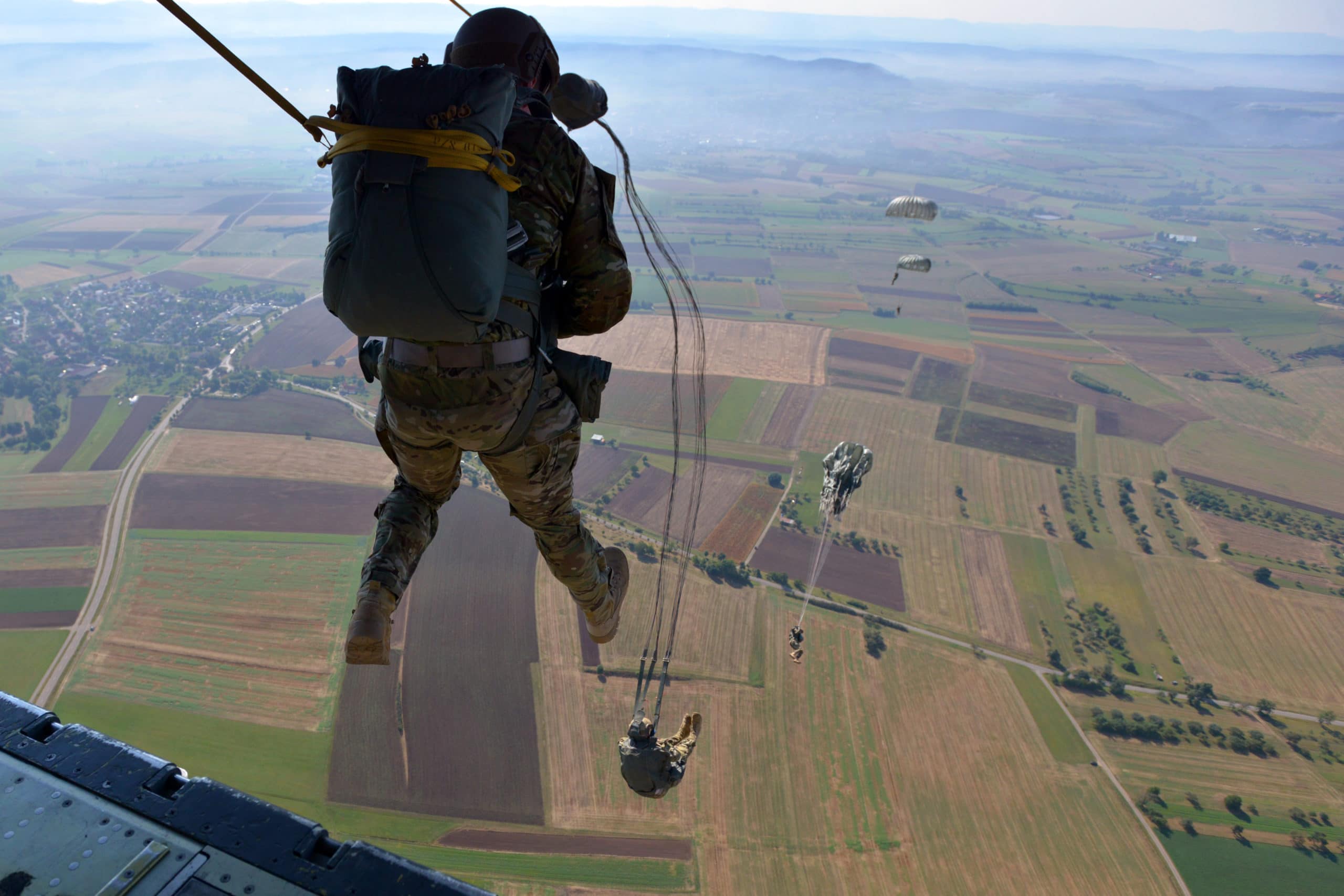December 15, 2020 | Defending Forward Monograph
Preserving America’s Military Posture in Germany
December 15, 2020 | Defending Forward Monograph
Preserving America’s Military Posture in Germany
President Trump appears to view the U.S. military presence in Germany as a favor or charity. He has also linked it to German defense spending.1
“They are delinquent of billions of dollars, this is for years delinquent,” Trump said in June. “So we are putting the number down to 25,000 soldiers.”2 Trump reiterated the message in June – “So, I said until they pay, we’re removing our soldiers, a number of our soldiers” – and again in July.3
Berlin has indeed persistently fallen short of its commitment to devote 2 percent of GDP to military expenditures by 2024.4 Germany devoted 1.36 percent of its 2019 GDP to defense (up from 1.18 percent in 2014, the year Russia invaded Crimea).5 Insufficient defense spending reduces the resources available to support alliance objectives. It also deprives the German military of the resources it needs to maintain sufficient military capability, capacity, and readiness.6
There is also a mismatch between Germany’s 2 percent target and where NATO and Washington most need Berlin to invest. As NATO’s border has shifted eastward, Germany has gone from a frontline state to a rear area logistical hub. Thus, in addition to integrated air and missile defense, Germany most needs to invest in cyber-protected logistical and transportation infrastructure to quickly push reinforcements eastward during a crisis. Such investments are not currently captured by the 2 percent metric.7
Regardless, America has every right to demand that NATO allies carry their fair share of the defense burden – a point Republican and Democrat administrations have emphasized for decades. Yet since 1949, only Trump has risked the credibility of NATO’s deterrent as a means of pressuring U.S. allies. Both before and after becoming president, Trump suggested that the United States might not honor its Article 5 commitment to its allies if they did not fulfill their defense spending commitments.8
This brand of hardball may have played a role in prompting increased defense spending among NATO allies in Europe.9 NATO Secretary General Jens Stoltenberg has credited Trump for this increase in defense spending (although Moscow’s 2014 invasion and annexation of Crimea likely provides the predominant explanation for the increase).10
Missing from this debate is the fact that American troops are in Germany because their presence serves U.S. interests. NATO represents one of America’s greatest grand strategic assets. Moreover, the U.S.-German bilateral relationship serves as a key pillar of this alliance and, by extension, of the stability and security of Europe. The Trump administration’s approach to Germany and the U.S. military posture has imperiled this.11 The United States should recommit to a robust military presence in Germany, while addressing any disagreements with Berlin, which only help Moscow.
This is fully consistent with the 2018 U.S. NDS, which declares “[l]ong-term strategic competitions with China and Russia” to be the Pentagon’s “principal priorities.” In terms of countering Russia, NATO is a key asset. The NDS accordingly describes efforts to fortify the alliance as one of the Pentagon’s top priorities.12 By conveying to Moscow that the alliance is unified, determined, and capable of protecting every member, NATO can deter the Kremlin from attacking NATO countries, as it has for more than seven decades.13
As General (Ret.) Philip Breedlove, who previously served as the top U.S. and NATO commander in Europe, recently noted, “NATO is more important now than it’s ever been since the fall of the [Berlin] wall” in 1989.14
For one, U.S. military posture in Europe helps build the readiness of NATO allies and improve interoperability – ultimately decreasing the security burden on the United States. This is a top priority as the United States looks to right-size and adjust its military posture around the world.
America’s military presence in Europe helps Washington conduct and support U.S. military operations in the Mediterranean, Africa, and the Middle East. Germany hosts the best U.S. military training facilities in Europe and some of America’s most important bases.15 Many U.S. bases in Germany have played a vital role in supporting operations in Iraq and Afghanistan, for example.16
The U.S. military presence in Germany also deepens and broadens vital political, diplomatic, and people-to-people ties between the two countries. That is particularly important given the geographic position of Germany, the size of its economy, and Berlin’s power within NATO, the European Union, and Europe more broadly.17 In other words, it will be quite difficult to maintain the unity of NATO if U.S.-German relations continue to deteriorate.18
It is also worth remembering that Germany supported NATO’s invocation of Article 5 for the first time in the alliance’s history following the 9/11 terrorist attacks on the United States. Over the subsequent years, thousands of Germans have served in Afghanistan alongside Americans – with some Germans paying the ultimate price. As of June 2020, 1,300 German troops were still serving in Afghanistan – second-most among alliance members, behind only the United States.
Nevertheless, the Trump administration in July 2020 announced a significant reduction in the U.S. military presence in Germany. Then-Defense Secretary Mark Esper said the United States will reduce the U.S. military presence in Germany from 36,000 troops to 24,000, adding that “nearly 5,600 service members will be repositioned within NATO countries, and approximately 6,400 will return to the United States.”19
Among the 5,600 service members repositioning within Europe, many will go to Belgium or Italy. In light of the stated reason for moving troops out of Germany, this shift is odd. Both countries spend less on defense as a measure of GDP than does Germany.20 Belgium spent 0.93 percent of its GDP on defense in 2019, and Italy spent 1.22 percent.21
Under the relocation plan, the headquarters of U.S. European Command and U.S. Special Operations Command Europe would move to Belgium. The Pentagon argues this co-location with Supreme Headquarters Allied Powers Europe in Mons will improve staff coordination. But in the age of modern communication, such benefits seem paltry compared to the move’s costs to the Defense Department’s budget and to the U.S. relationship with Germany.22
The potential movement of some operational units may also require scrutiny. Under the plan, for example, one F-16 squadron would move from Germany’s Spangdahlem Air Base to Aviano Air Base in Italy. While moving this would provide additional air power closer to the Eastern Mediterranean and Black Sea, Aviano already hosts two F-16 squadrons. There is also a question as to whether Aviano has sufficient infrastructure to host a third F-16 squadron.23 Moreover, some of these moves will take months or years, especially when congressionally authorized and appropriated military construction is required.24
Esper said these decisions were part of an ongoing review of the U.S. military posture in all combatant commands.25 Unfortunately, if some of these decisions are executed, their primary victim will be U.S. national security interests.
It is, of course, necessary for the Pentagon to continually reassess and adjust U.S. overseas military posture, including in Germany. It certainly makes sense to shift some forces to strengthen NATO’s eastern flank – in Poland, the Baltics, and the Black Sea region. A continuous Stryker Brigade rotation in the Black Sea region may also make sense.26 Such moves, however, should be solely focused on securing U.S. national security interests and be conducted in a manner that does not sow unnecessary discord in the alliance or damage the U.S.-Germany defense relationship.

U.S. soldiers exit from the ramp of a U.S. Air Force C-130 Hercules aircraft during an Airborne operations parachute jump near Stuttgart, Germany, September 21, 2016. Led by jumpmasters from Special Operations Command Africa, airborne operations like these help personnel maintain proficiency and increase the unit’s readiness for expeditionary deployments. (Photo via U.S. Army Visual Information Specialist Jason Johnston)
There is also a question regarding readiness. Any adjustments to U.S. force posture in Europe should focus on readiness. The movement of some capabilities from Germany to Italy, or keeping Air Force capabilities at Mildenhall Air Base in England instead of Spangdahlem or other bases in Germany, may not help readiness. It is worth remembering that facilities at Mildenhall are among the Air Force’s oldest in Europe, while Spangdahlem’s are among the newest.Admittedly, the plan may add some needed enhanced military capability on NATO’s flank. However, these gains are coming at the cost of reduced NATO unity and damage to America’s bilateral relationship with Germany. For these reasons, Congress would be wise to exercise robust oversight of the proposed moves and perhaps even send the Pentagon back to the drawing board.
A similar version of this chapter originally appeared in Defense One on October 5, 2020.27
